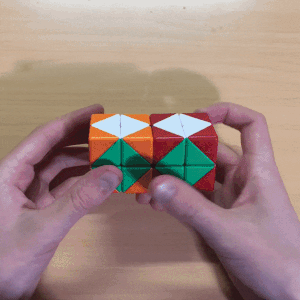Canonical Moves
If you were handed a physical 2x2x2x2 without explanation, it is not obvious how you would turn it as a puzzle. This is why the official canonical moveset exists. These are comprised of the basic moves that the community agrees on. Only these moves can be used for official solutions in the Hall of Fame.
Watch [Melinda's video] for a detailed overview.
Contents
History
Before the first prototype of the 2^4 was made, Melinda's diagram (at left) showed the simple rotations of the puzzle. It was obvious that you could rotate those 2 sides in any way you wanted. Gradually, through mailing list community consensus, the move set was narrowed down to just a couple of moves, plus a gyro. These moves are listed below.
The canonical moves don't include some moves that are easy to show their relationship to the virtual puzzle. For example, a Ux2 move maps to the physical puzzle in a fun way, but isn't included. Check out [video] to see some extra moves that could theoretically be included in the future.
Canonical Moves
Simple Rotation
You can 4D rotate the puzzle by rotating the cubic halves along each other symmetrically, such that the puzzle state stays the same. However, this does not allow you to reach every orientation of the puzzle. The gyro algorithm is necessary for reaching the rest of the orientations.
Cube cell turns
You can rotate the 2 cubic cells in any way you want, as this corresponds perfectly with rotating them on the physical puzzle. Melinda's video calls this an "arbitrary half puzzle juxtaposition".
The notation for these moves is to use the Rubik's Cube notation with x, y, & z rotations. x goes in the same direction as R, y is like U, and z is like F. Any reorientation is generally considered to be 1 move. For example, doing Rx,y2 would be 1 move.
Long cell turns
From the horizontal position, the long cells are the U, F, D, & B cells. They can be twisted as if they were the sides of a 2x2x4 cuboid. These moves are notated U2, F2, D2, or B2. Technically their rotational plane should be specified more, as on the virtual puzzle, U2 could mean Ux2, Uy2, or Uz2. However, only one of these twists is canonical for each side. These are Uy2, Fz2, Dy2, and Bz2.
Gyro
In order to access full turns of other sides, it is needed to 4 dimensionally rotate the puzzle in such a way that the x axis stickers change. This is called a "gyro". There are many possible gyro algorithms, all of which have to use some sort of illegal (non-canonical) twist at some point. Watch [Melinda's video] on gyro algorithms.
"The gyro basically rapidly disassembles and reassembles the puzzle in the same state but rotated 4 dimensionally" - Markk

